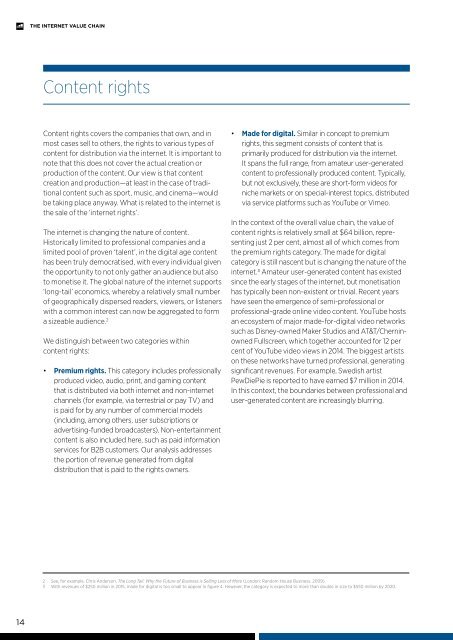The Internet Value Chain
GSMA_The-internet-Value-Chain_WEB
GSMA_The-internet-Value-Chain_WEB
Create successful ePaper yourself
Turn your PDF publications into a flip-book with our unique Google optimized e-Paper software.
THE INTERNET VALUE CHAIN<br />
Content rights<br />
Content rights covers the companies that own, and in<br />
most cases sell to others, the rights to various types of<br />
content for distribution via the internet. It is important to<br />
note that this does not cover the actual creation or<br />
production of the content. Our view is that content<br />
creation and production—at least in the case of traditional<br />
content such as sport, music, and cinema—would<br />
be taking place anyway. What is related to the internet is<br />
the sale of the ‘internet rights’.<br />
<strong>The</strong> internet is changing the nature of content.<br />
Historically limited to professional companies and a<br />
limited pool of proven ‘talent’, in the digital age content<br />
has been truly democratised, with every individual given<br />
the opportunity to not only gather an audience but also<br />
to monetise it. <strong>The</strong> global nature of the internet supports<br />
‘long-tail’ economics, whereby a relatively small number<br />
of geographically dispersed readers, viewers, or listeners<br />
with a common interest can now be aggregated to form<br />
a sizeable audience. 2<br />
We distinguish between two categories within<br />
content rights:<br />
• Premium rights. This category includes professionally<br />
produced video, audio, print, and gaming content<br />
that is distributed via both internet and non-internet<br />
channels (for example, via terrestrial or pay TV) and<br />
is paid for by any number of commercial models<br />
(including, among others, user subscriptions or<br />
advertising-funded broadcasters). Non-entertainment<br />
content is also included here, such as paid information<br />
services for B2B customers. Our analysis addresses<br />
the portion of revenue generated from digital<br />
distribution that is paid to the rights owners.<br />
• Made for digital. Similar in concept to premium<br />
rights, this segment consists of content that is<br />
primarily produced for distribution via the internet.<br />
It spans the full range, from amateur user-generated<br />
content to professionally produced content. Typically,<br />
but not exclusively, these are short-form videos for<br />
niche markets or on special-interest topics, distributed<br />
via service platforms such as YouTube or Vimeo.<br />
In the context of the overall value chain, the value of<br />
content rights is relatively small at $64 billion, representing<br />
just 2 per cent, almost all of which comes from<br />
the premium rights category. <strong>The</strong> made for digital<br />
category is still nascent but is changing the nature of the<br />
internet.3 Amateur user-generated content has existed<br />
since the early stages of the internet, but monetisation<br />
has typically been non-existent or trivial. Recent years<br />
have seen the emergence of semi-professional or<br />
professional-grade online video content. YouTube hosts<br />
an ecosystem of major made-for-digital video networks<br />
such as Disney-owned Maker Studios and AT&T/Cherninowned<br />
Fullscreen, which together accounted for 12 per<br />
cent of YouTube video views in 2014. <strong>The</strong> biggest artists<br />
on these networks have turned professional, generating<br />
significant revenues. For example, Swedish artist<br />
PewDiePie is reported to have earned $7 million in 2014.<br />
In this context, the boundaries between professional and<br />
user-generated content are increasingly blurring.<br />
2 See, for example, Chris Anderson, <strong>The</strong> Long Tail: Why the Future of Business is Selling Less of More (London: Random House Business, 2009).<br />
3 With revenues of $250 million in 2015, made for digital is too small to appear in figure 4. However, the category is expected to more than double in size to $550 million by 2020.<br />
14


